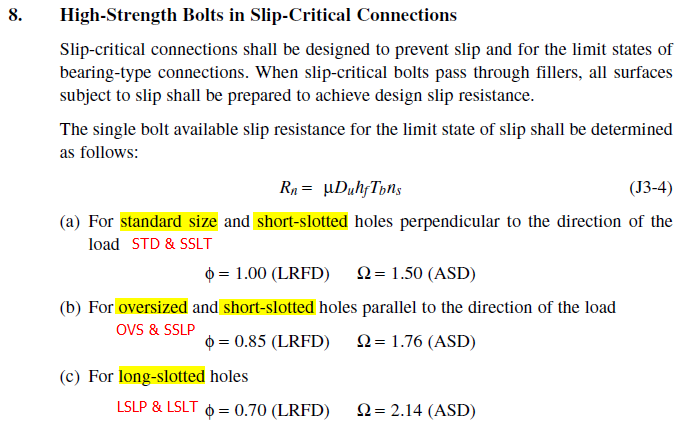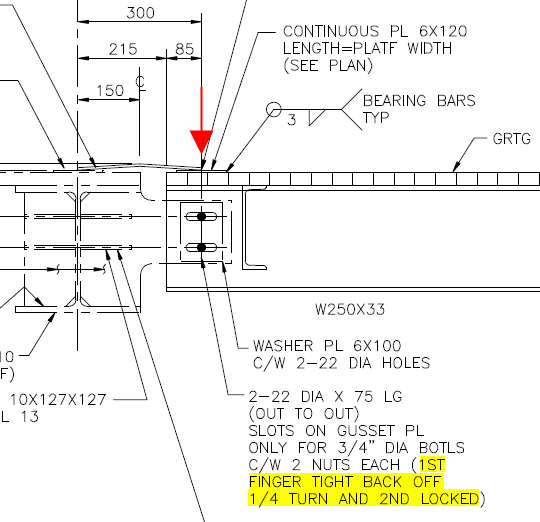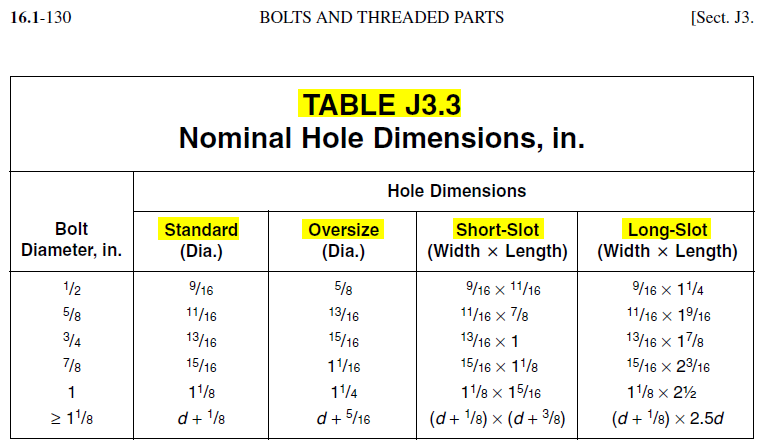Below is the AISC Manual code provisions to deal with different bolt hole types

>> Can you verify that SSLT holes can be used with bearing
type bolts?
When user selects Consider slip critical =
Yes
, no matter what type of bolt hole is selected, the program will check
both bolt bearing and
bolt slip critical in
the bolt shear capacity check.
>> I went into the SC bolt tab, set the slots in the plate
then clicked "no" for SC bolts, is that correct?
If user needs slip critical check, user must select Consider slip critical =
Yes
Whether you need slip critical check or not, it all depends on the
load of concern and
slotted hole direction
in your connection design. Look at sketch below
In Case 1, it is slotled hole connection in a hanger case, purpose
of slotted hole is to account for construction tolerance when steel connecting to
concrete.
In this case you need slip critical check so you must select Consider slip critical
=
Yes
In Case 2, it is slotled hole for a beam case, purpose of slotted
hole can be 1) for construction tolerance OR 2) for expansion joint
In case 2 the load of concern is apparently the vertical shear load, not the horizontal
beam axial load. In this case user can choose LSLT/SSLT or even STD
bolt hole as only vertical shear bolt bearing check is a concern. In the horizontal
slotted hole direction, not only slip critical friction resistance is not a concern,
user may further expect it to move freely for expansion joint case, so user doesn't
need slip critical check at all in this case, and user can choose STD hole instead
of slotted hole in this connection design.

Look at sketch below, in the beam end slotted hole case, when you see the yellow
highlighted note
1ST NUT FINGER TIGHT THEN BEACK OFF 1/4 TURN
...
That indicates that the slotted hole here is for expansion joint purpose, the bolts
are allowed to move freely in horizontal direction like a roller, so the slip
critical check is
NOT required in this case because
1) The load of cencern is vertical load. In horizontal direction instead of slip
critical friction resistance, we want to release it
2) In vertical direction it's not slotted hole. Bolt bearing is checked in vertical
direction so slip critical is not required.
For this case, user can select Consider slip critical =
No
and use
STD hole in connection design although
in detail it's a slotted hole connection.

>> I have not been able to verify if slots are accounted for
in the calc's or not.
If Consider slip critical =
Yes is selected, the
program will do additional bolt slip critical check on top of bolt bearing check
for shear
If Consider slip critical =
No is selected, the
program will only do the bolt bearing check for shear
>> Your output does not show that for slotted hole the
enlarged hole size is considered in
plate Block Shear check plate net area Ant and Anv calculation
It's correct that the enlarged slotted bolt hole or oversized bolt hole is not
considered in Plate Block Shear plate net area A
nt and A
nv
calculation.
In the Plate Block Shear calculation, all bolt holes are assumed to be standard
bolt holes.
When there are slotted or oversized bolt holes, User can select the
bolt hole type
as SSLT/SSLP or LSLT/LSLP or OVS from Bolt Hole Type pulldown in the bolt
setup
dialog box. This will generate an accurate calculation for Bolt Slip Critical
check.
For Plate Block Shear check, user can just simply
increase
the bolt edge distance manually, in the slotted hole direction only, after finishing
the calculation.
For example, the 1" dia bolt STD hole d
h =1-1/8", long slotted
hole out-out length=2-1/2", one side extra length=(2.5 - 1.125) /2 =0.688",
we round it up to 0.75"
Assume bolt edge distance is 1.5", user can increase the bolt edge distance to
1.5" + 0.75" = 2.25", in long slotted hole direction only as final bolt edge
distance.
This manual increase of bolt edge distance will make sure that the Plate Block Shear
check is now accurate.
Below is the bolt slotted hole size from AISC Design Manual Table J3.3
